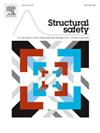基于深度学习的高级地形自适应热带气旋风场建模,用于基础设施弹性规划
IF 6.3
1区 工程技术
Q1 ENGINEERING, CIVIL
引用次数: 0
摘要
热带气旋对沿海社区的恢复能力构成重大威胁,强调需要可靠的风场模型来支持强有力的危害分析。参数风模型(PWMs)尽管计算效率很高,但在捕捉复杂的风-地形相互作用方面往往不足,导致对位于复杂地形的空间分布式民用基础设施系统的弹性评估不准确。本研究介绍了一种创新的方法,通过基于深度学习的卷积神经网络地形改造(CNN-TM),将数值风模型处理复杂地形特征的优势整合到pwm中。CNN-TM模型训练了超过300万平方公里的数值模拟高分辨率风场,通过生成450米分辨率的风速和风向地形修正风场,增强了PWMs中的地形表征。这种整合的准确性和效率在多个尺度上得到了验证:网格(~ 0.2 km2)、斑块(~ 506 km2)和区域(~ 34,000 km2)。在中国浙江省台风黑格比(2020)期间的应用,在105,000平方公里的面积上证明了其实际有效性。通过利用深度学习来协同数值模型和参数模型,CNN-TM模型解决了传统PWMs的局限性,并为具有复杂地形特征的沿海地区基础设施系统的弹性导向决策提供了强大的工具。本文章由计算机程序翻译,如有差异,请以英文原文为准。
Advanced terrain-adaptive tropical cyclone wind field modeling using deep learning for infrastructure resilience planning
Tropical cyclones pose significant threats to the resilience of coastal communities, underscoring the need for reliable wind field models to support robust hazard analyses. Parametric wind models (PWMs), despite their computational efficiency, often fall short in capturing intricate wind-terrain interactions, leading to inaccurate resilience evaluations for spatially-distributed civil infrastructure systems situated in complex terrains. This study introduces an innovative approach that integrates the strengths of numerical wind models to handle intricate terrain features into PWMs through a deep learning-based Convolutional Neural Network for Terrain Modification (CNN-TM). The CNN-TM model, trained over 3 million km2 of numerically simulated high-resolution wind fields, enhances terrain representation in PWMs by generating 450 m-resolution terrain-modified wind fields for both wind speed and direction. The accuracy and efficiency of this integration are validated across multiple scales: grid (∼0.2 km2), patch (∼506 km2), and region (∼34,000 km2). Applications during Typhoon Hagupit (2020) in Zhejiang Province, China, demonstrate its practical effectiveness across a 105,000 km2 area. By leveraging deep learning to synergize numerical and parametric models, the CNN-TM model addresses limitations of traditional PWMs and provides a robust tool for resilience-oriented decision-making for infrastructure systems in coastal regions characterized by complex terrains.
求助全文
通过发布文献求助,成功后即可免费获取论文全文。
去求助
来源期刊

Structural Safety
工程技术-工程:土木
CiteScore
11.30
自引率
8.60%
发文量
67
审稿时长
53 days
期刊介绍:
Structural Safety is an international journal devoted to integrated risk assessment for a wide range of constructed facilities such as buildings, bridges, earth structures, offshore facilities, dams, lifelines and nuclear structural systems. Its purpose is to foster communication about risk and reliability among technical disciplines involved in design and construction, and to enhance the use of risk management in the constructed environment
 求助内容:
求助内容: 应助结果提醒方式:
应助结果提醒方式:


